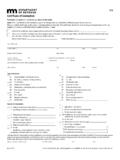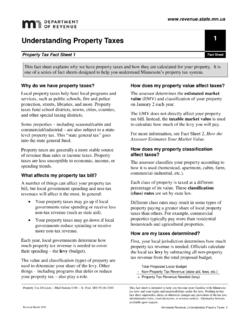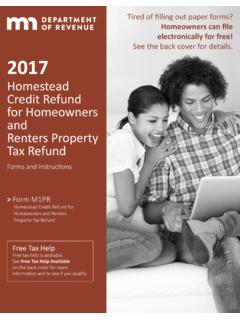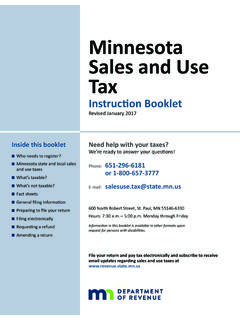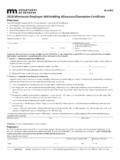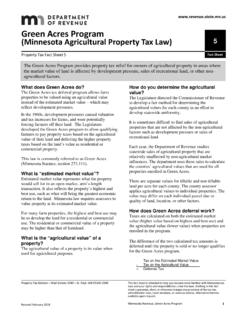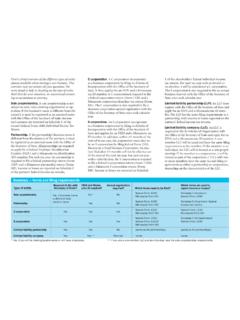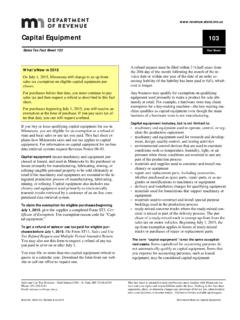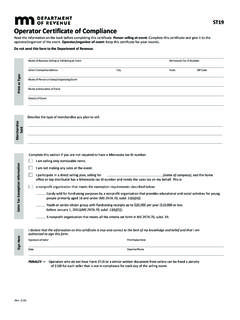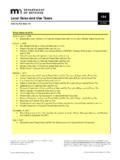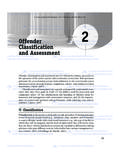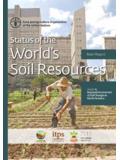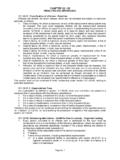Transcription of Classification of Property
1 Classification of Property In Minnesota, Property is classified according to its use on the assessment date January 2. If the Property is not currently being used, it is classified according to its most probable, highest and best use. Highest and best use is the use that is financially feasible, physically possible, legally permissible, and maximally productive. There are five basic classes of Property in Minnesota (Minnesota Statutes ). The 2008 legislative session resulted in significant changes to some of the classes of Property in Minnesota. Please be aware that the classes and class rates prior to 2008 may be rather different than what is now law. This may cause additional confusion for taxpayers. The information presented here will try to address them all.
2 A list of class rates is provided at the end of this chapter for the 2010 assessment Tax Capacity The Uniformity Clause of the Minnesota Constitution allows for different classes of Property to be taxed at different rates. As the first step in calculating Property taxes, the class rate is used to determine a Property s tax capacity. Tax capacity is calculated using the following formula: Taxable Market Value x Class Rate = Tax Capacity Class 1 Class 1a Residential Homestead Real estate that is residential and used for homestead purposes is Class 1a. Homestead Property is covered in greater detail in the next chapter. For the current assessment year the class rate for 1a Property is 1 percent for the first $500,000 in value and percent for any value over $500,000.
3 Class 1b Blind/Disabled/Surviving Spouse of Paraplegic Vet Homestead Class 1b includes residential homestead or homestead manufactured homes used by: 1. any person who is blind as defined in section , subdivision 4a, or the blind person and the blind person s spouse ( Property is classified and assessed pursuant to this clause only if the Commissioner of Revenue or county assessor certifies that the homestead occupant satisfies the requirements of this paragraph); 2. any person who is permanently and totally disabled or the disabled person and the disabled person s spouse ( Property is classified and assessed pursuant to this clause only if the government agency or income-providing source certifies that the homestead occupant satisfies the disability requirements of this paragraph and the Property is not eligible for the Disabled Veterans Value Exclusion); or 3.
4 The surviving spouse of a permanently and totally disabled veteran already homesteading a Property classified under this Classification for taxes payable in 2008. Property receiving the market value exclusion for homesteads of disabled veterans (discussed in Chapter 18) will not qualify for class 1b. The Minnesota Department of Revenue originally awarded and maintained the blind and disabled classifications. Starting October 1, 2008, county assessors will administer this Classification . Property owners need only to file a blind/disabled application once not annually as required prior to the 2004 assessment . For the current assessment year the first $50,000 in market value of class 1b Property has a net class rate of.
5 45 percent. The remaining market value of class 1b Property has a class rate using the rates for class 1a or agricultural homestead Property , whichever is appropriate. 2 Classification of Property Class 1c Commercial Seasonal Residential Recreational under 250 days and includes homestead (Ma & Pa Resorts) Class 1c is commonly known as the Ma & Pa Resort class. It is commercial use real and personal Property that abuts public water and is devoted to temporary and seasonal residential occupancy for recreational purposes, but not devoted to commercial purposes for more than 250 days a year. It must contain three or more rental units ( cabin, sleeping room, campsite, etc.) and provide recreational activities ( snowmobiles, launch services, etc.)
6 It includes a portion used as a homestead by the owner, which includes a dwelling occupied as a homestead. In addition to being occupied as a homestead by an owner as sole proprietor, the dwelling can be occupied by a shareholder of the corporation, a partner in a partnership, or a member of a limited liability company (LLC) that owns the resort even if the corporation, partnership, or LLC holds the title to the homestead. A new provision added in 2010 allows for an owner of a class 1c resort to no longer use that resort as a homestead but continue receiving the Classification . The owner must continue to operate it as a resort and occupy another resort as a homestead in the same township. If these requirements are met, both properties will be assessed as a single class 1c resort (with one tier).
7 For the purposes of this Classification , Property is considered to be devoted to a commercial purpose on a specific day if any portion of the Property , excluding the portion used exclusively as a homestead, is used for residential occupancy and a fee is charged. The portion of the Property occupied as a homestead by the owner should be classified as class 1a residential homestead (the class rate for 1a Property is 1 percent for the first $500,000 in value and percent for any value over $500,000). The remainder of the Property should be classified as class 1c. Starting with the 2008 assessment , the tier I rate was reduced to .50 percent and was extended to the first $600,000 in value. The tier II rate stayed the same (1 percent) and is for the next $ million.
8 Any value over $ million will be at the tier III rate ( percent) and will pay the state general tax. Owners of Property desiring Classification as class 1c must submit a declaration to the assessor s office and provide guest registers or other records by January 15 of the assessment year that show which cabins or units were occupied for 250 days or less in the year proceeding the year of assessment . Qualifying cabins or units and a proportionate share of the land on which they are located will be designated class 1c. Non-qualifying cabins or units and a proportionate share of the land on which they are located will be designated as class 3a commercial. Any unit that transfers the right to use the Property to an individual or entity by deeded interest, or the sale of shares or stocks, will no longer qualify for class 1c, even if that unit may remain available for rent.
9 Any portion of a Property operated as a restaurant, bar, gift shop, or other non-residential facility operated on a commercial basis not directly related to temporary and seasonal residential occupancy for recreational purposes shall not qualify for class 1c. This portion of the Property should be classified as class 3a commercial or possibly class 4c(10) for a qualifying restaurant located on a lake. Class 1d Migrant Housing Class 1d Property includes structures only (no land) that meet all of the following criteria: The structure is located on land that is classified as agricultural Property ; The structure is occupied exclusively by seasonal farm workers during the time they work on that farm; and the occupants are not charged rent for the privilege of occupying the Property , provided that use of the structure for storage of farm equipment and produce does not disqualify the Property from Classification under this paragraph; The structure meets all applicable health and safety requirements for the appropriate season.
10 And The structure is not saleable as a residential Property because it does not comply with local ordinances relating to location in relation to streets or roads. For the current assessment year the class rate for 1d Property is 1 percent for the first $500,000 in value and percent for any value over $500,000. Minnesota Department of Revenue | Property Tax Division 3 Class 2 Class 2a Agricultural Land Class 2a agricultural land consists of parcels of Property , or portions of parcels, that are agricultural land and buildings it is not necessarily homestead. An agricultural homestead consists of class 2a land that qualifies for homestead plus any class 2b rural vacant land that is contiguous to the class 2a land and under the same ownership.
